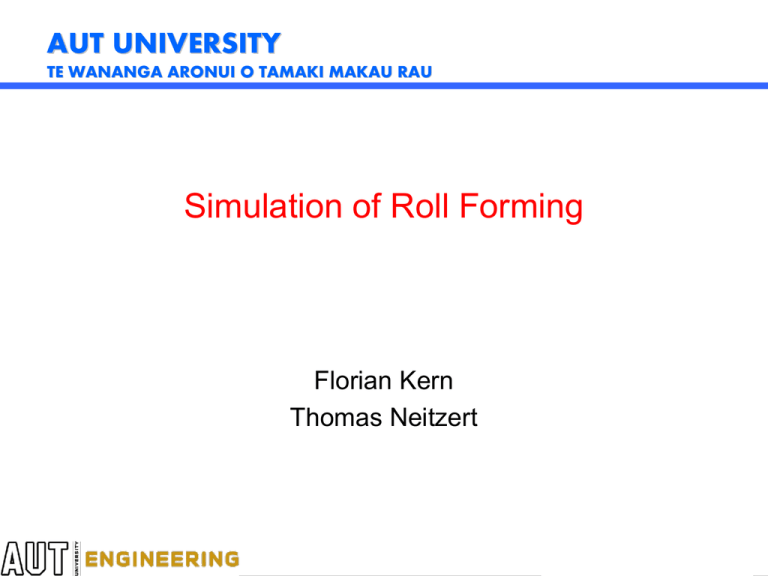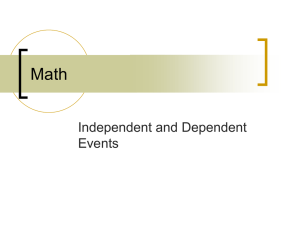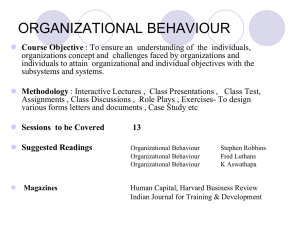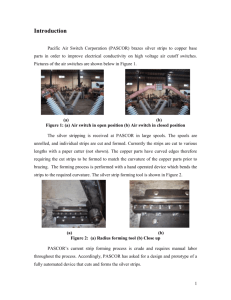PPS2: Manufacturing Methods for Composite Structural Assemblies
advertisement

AUT UNIVERSITY TE WANANGA ARONUI O TAMAKI MAKAU RAU Simulation of Roll Forming Florian Kern Thomas Neitzert Outline • Introduction • Roll forming • New developments • Simulation of U-channel • Summary and future work Roll Forming • Bending process • Angle introduced continuously along straight line • Set of contoured rolls • Strip motion applied by rotation of rolls (friction) • Alternatively, pulling of strip • Unlimited length Source: Schuler Roll Forming - Boundaries • Generally, materials that can be bent can also be roll formed • Steel: – – – – Thickness 0.1mm to 20mm Width 3mm to 2m Velocity 20m/min to 80m/min, some up to 160m/min More demanding for higher yield strengths • Product is prismatic Typical Defects in Roll Forming • Camber – Curving in horizontal plane • Bow – Curving in vertical plane • Twist – Rotation around longitudinal axis Source: Halmos y Roll Forming – Latest Developments x z • Flexible roll forming Source: PtU • Rolls with addition DOF – Rotation – Lateral translation • NC y Source: PtU • Variable cross sections Source: PtU x Source: PtU Roll Forming – Latest Developments • MONRO • Variable cross-section, different scale • Stands separated, each side movable • Applied as cladding of large buildings Source: The Fabricator Source: BEMO Systems Forming specialities • Linear flow splitting Source: PtU Source: PtU Source: PtU • Double-sided flanges without joints • Cold forming • Excellent surface quality • Considerable increase in hardness Integration of processes Laser assisted bending • Appreciable extension of forming limits of high strength steel (up to 200%) • Hardly any permanent softening of steel Source: LFT Aides for Manufacturing • Simulation of forming process – Several software packages specialised on roll forming • • • • • PROFIL (Ubeco) COPRA (dataM) Shape-RF (SHAPE Co) Simply Roll Design (Delta Engineering) VTTube (VTT) Source: SHAPE Source: dataM Simulation of U-channel • • • • • Abaqus explicit 6 stands Stand spacing 300mm 4-node shell elements (S4R) Symmetric Model parameters Material Isotropic, linear hardening Young’s modulus 210GPa Yield strength 300MPa Strip Thickness 1mm Strip Velocity 1mm/ms Coefficient of Friction 0 Roll diameter 200mm Roll material Analytically rigid Tool • Constant Radius • 15° angle increment 56 49 1 R3 150 Simple U-Channel Results: Strains at channel edge Shear Strains at edge of flange (top) Longitudinal 0.002 Transverse 0.0015 0.001 Strain 0.0005 0 -0.0005 -0.001 -0.0015 -0.002 -0.0025 0 1 2 3 4 5 6 Stands Shear Strains at edge of flange (bottom) Longitudinal 0.002 Transverse 0.0015 0.001 Strain 0.0005 0 -0.0005 -0.001 -0.0015 -0.002 -0.0025 0 1 2 3 Stands 4 5 6 Results: Stresses at channel edge Shear Stresses at edge of flange (top) Longitudinal 0.3 Transverse 0.2 Stress (Gpa) 0.1 0 -0.1 -0.2 -0.3 0 1 2 3 4 5 6 Stands Shear Stresses at edge of flange (bottom) Longitudinal 0.3 Transverse 0.2 Stress (Gpa) 0.1 0 -0.1 -0.2 -0.3 0 1 2 3 Stands 4 5 6 Roll Former at AUT • 7 Stands (5 currently in use) • Rolls supported at both ends (Standard design) • All lower and first upper roll driven ( line of transfer gearboxes) • Max. strip width: 350mm • Old production tool installed • Cut-off die • Decoiler Simulation of existing tool Summary and future work • New developments • Created simulation of – U-channel and – Production tool • Develop versatile research tool • Verify simulation • Progress to more complex geometry • Develop design aide for roll forming Thank you









